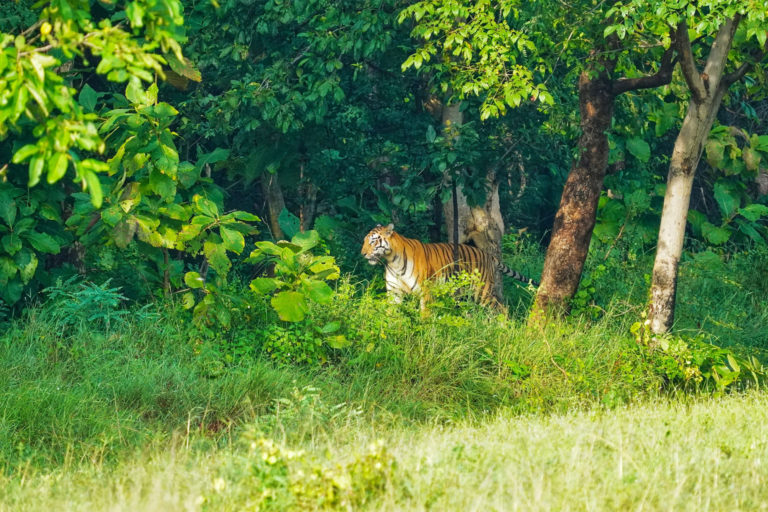- Nepal was home to 121 tigers in 2010, the same year that it and 12 other tiger range countries agreed to double the big cat’s global population by 2022.
- Since then, Nepal has nearly tripled that figure, and is now home to 355 tigers, As the number of tigers has increased, cases of attacks on humans and livestock have also gone up, raising concerns over the price that local communities are paying for tiger conservation success.
- Overemphasis on tigers may also be leading to neglect of other important species that are just as threatened, experts warn. Despite the success, threats remain: government plans to build roads and railways through important habitats could severely affect tiger populations, a study has found.
KATHMANDU — The country received accolades and applause from all around the world for its success in conserving the endangered species. However, with the growing number of big cats, attacks on humans and livestock have also gone up. Similarly, the success of the tiger-focused conservation approach comes at the experts say.
Even so, Nepal’s tigers aren’t out of the proverbial woods yet. An ongoing spree of road and railway construction through important habitats is going to severely affect the population, a study warns.
With all eyes on this iconic apex predator throughout 2022, here’s how Mongabay reported from Nepal on the Year of the Tiger:

Nepal was supposed to double its tiger population since 2010. It tripled it
There are officially 355 wild tigers in Nepal, according to the latest census, nearly triple the figure of 121 from 2010. Nepal is one of 13 tiger range countries that pledged in 2010, the last Year of the Tiger in the Chinese zodiac, to double the global tiger population by 2022, the current Year of the Tiger.
The massive conservation success is expected to make Nepal the only one of the tiger range countries to even come close to doubling its population of the big cat.
But Nepal’s success has also raised concerns that its tiger population may fast be approaching the limit of what the country’s protected areas can host, with implications for an increase in human-tiger conflicts.

As Nepal’s tigers thrive, Indigenous knowledge may be key in preventing attacks
As Nepal nearly tripled its tiger population this year from a 2010 baseline, its conservation success has had a high cost on forest-dependent communities.
Incidents of human-tiger conflict have increased in line with the growing populations of both the big cats and people, as more people venture into national parks and their buffer zones in search of firewood and food. Some conservationists make the case that grassland management and other techniques long practiced by Indigenous communities to avoid tiger attacks have been lost with the establishment of these parks where human activity is banned.
They suggest current conservation management makes attacks more likely, and call for conservation officials to share information on tiger movements with local communities to minimize the likelihood of encounters.

‘South Asia needs its own tiger plan’: Q&A with Nepal’s Maheshwar Dhakal
Maheshwar Dhakal, director-general of Nepal’s Department of National Parks and Wildlife Conservation, says a regional plan is needed to sustain the Bengal tiger population. Following the department’s success in nearly tripling Nepal’s tiger population since 2010, Dhakal says other government agencies can also contribute by promoting ecotourism and boosting local livelihoods.
In a Q&A with Mongabay, he also emphasized the importance of transboundary conservation action, noting that the punishment for tiger poaching in India, where tigers from Nepal often stray into, is much more lenient than in Nepal.

Tiger-centric conservation efforts push other predators to the fringes
Nepal and India have made huge strides in boosting their tiger populations over the past decade, but these conservation actions may have come at the expense of other predators, research shows.
In Nepal, species such as leopards and sloth bears have been pushed to the fringes of conservation areas that have been optimized for tigers, leading to increased human-wildlife conflict. The current approach of burning tall grasses and rooting out tree shoots to give deer and antelope fresh grass, and tigers fresh prey, isn’t even working in the tigers’ favor, one study shows. Conservationists say there needs to be a habitat management approach that accommodates a wider range of both prey and predator species.

Nepal’s key habitat could lose 39% of its tigers in 20 years, study says
Nearly two-fifths of adult tigers in Nepal’s Chitwan National Park could be killed over the next 20 years as a result of vehicle strikes on the roads near the park, a new study says.
The projection is based on tiger movement data going back to the 1970s, and shows that the addition of a proposed railway line would result in an additional 30 tiger deaths.
The large number of projected losses would be devastating to the population, which is already increasingly cut off from its range in neighboring India as a result of human-made obstacles, including roads. The study authors say this worst-case scenario should be a wake-up call to authorities to plan infrastructure projects with wildlife mobility as a key concern.

As tiger numbers in Nepal and India grow, their freedom to roam shrinks
Nepal is one of the few countries to have doubled its tiger population from a 2010 baseline. But a growing sense of “animal nationalism” threatens to mar this success, with local media playing up the tigers’ travels across the border into India. The big cats, which don’t recognize political boundaries, have always roamed a wide range in this region, yet even this behavior is under threat as key corridors are restricted or cut off entirely by infrastructure projects by both countries. Conservationists have called for keeping nationalism out of planning and implementation of conservation efforts, for the sake of this iconic species.

In Nepal, endangered tiger kills critically endangered gharial. What does it mean?
In July, a tiger entered the Kasara gharial breeding center in Chitwan National Park and killed three of the critically endangered crocodiles.
The incident raised concerns that as the tiger population in Nepal increases, the animals could turn to the crocodiles for easy food.
Conservationists, however, say that’s unlikely as tigers have other animals to feed on
Banner image: A Bengal tiger sits on a road in neighboring India. Image by Hawkclicks via Flickr (CC BY-NC 2.0).
Abhaya Raj Joshi is a staff writer for Nepal at Mongabay. Find him on Twitter @arj272
Related reading:
Nepal reckons with the dark side of its rhino conservation success
